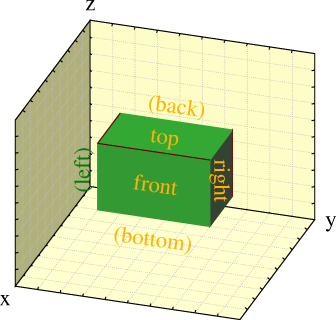
[No default.]
[No default.]
The normalisation of the vector is not used. Zero-norm vectors are not acceptable.
[By default, the box is not rotated i.e. the half lengths are assumed to have been measured along x, y and z.]
The charge is added to the surface charges needed to satisfy the boundary conditions. The box can either be a dielectric or a conductor.
In the process of being implemented - initially, the charge is equally distributed over all surfaces, selection of surface panels is planned to be added later.
Specifying this option implies the use of neBEM to solve the field.
Specifying this option implies the use of neBEM to solve the field.
In the process of being implemented.
Specifying this option implies the use of neBEM to solve the field.
Specifying this option implies the use of neBEM to solve the field.
| Type | Representation | Notes |
|---|---|---|
CONDUCTOR |
CONDUCTORS-1 |
Equivalent to CONDUCTOR-1 |
CONDUCTOR-1 |
CONDUCTORS-1 |
- |
CONDUCTOR-2 |
CONDUCTORS-2 |
- |
CONDUCTOR-3 |
CONDUCTORS-3 |
- |
DIELECTRICUM |
DIELECTRICA-1 |
Equivalent to DIELECTRICUM-1 |
DIELECTRICUM-1 |
DIELECTRICA-1 |
- |
DIELECTRICUM-2 |
DIELECTRICA-2 |
- |
DIELECTRICUM-3 |
DIELECTRICA-3 |
- |
[Default: CONDUCTOR]
This label serves the same purpose as the wire label for wires, namely the selection of the solid as a place where signals can be measured, around which isochrons are drawn etc.
[By default, no label is assigned.]
Garfield generates, for each solid, a set of flat panels that together cover the faces. These panels, arbitrary convex polygons, are sub-divided when isolating contact areas between solids and also in order to comply with the neBEM requirement that it be given only rectangles and right-angled triangles. The triangles and rectangles handed to neBEM are called "primitives".
For reasons of accuracy neBEM as a rule sub-divides the primitives into "elements", in a process called "discretisation". The sub-divisions of the primitives are called "elements".
Discretisation will perhaps eventually be automated, but for the time being this remains the responsability of the user. In neBEM, the level of discretisation requested is described by 2 integers: the number of elements that is to be generated along each of 2 sides adjacent to a right angle. Since the shape, orientation and size of the primitives are non-trivial to predict, the level of discretisation is specified on the Garfield side as the desired length of the sides of the elements.

The designation of the surfaces is as follows:
The discretisation length can be set in several ways, see Example\ 4 for the SOLIDS command:
Discretisation lengths have to be given in cm.
[Default: the TARGET-ELEMENT-SIZE that is in effect at the time the solids are read.]
Formatted on 21/01/18 at 16:55.